Nothing beats homemade vegetable stock (vegetable broth), and I've opted to use the slow cooker. This easy slow cooker vegetable stock recipe takes minutes to assemble, then you simply turn it on and leave it bubbling away for a few hours.
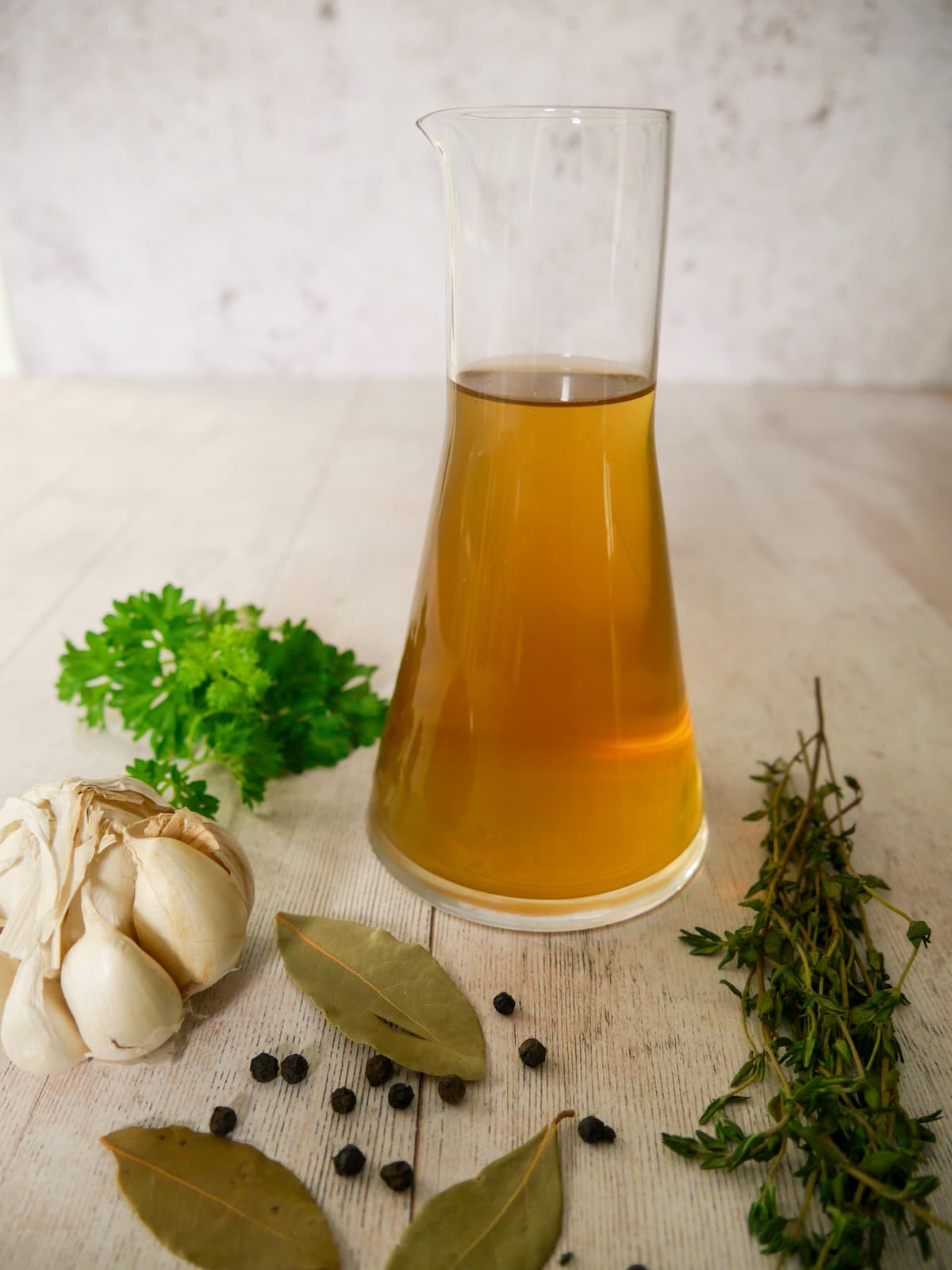
To my slow cooker vegetable broth, I've added fresh onion, leek, celery, carrots and garlic. I've also used the herbs you would typically find in a bouquet garni - thyme, parsley and bay. But rather than tie everything up, I just added them to the pot.
Now that I've made vegetable stock in the slow cooker, there's no going back. No standing over the stove, checking water levels, just switch it on and leave it. However, it can also be made on the stovetop, and I include instructions on how to do that later in the post.
Why you'll love this recipe
- Homemade stock is fresh flavoured and tastes better than store bought stock cubes.
- There's no salt or preservatives in a homemade vegetable stock, just fresh, raw ingredients.
- Quick to prepare just place everything into the slow cooker, and leave it to bubble away while you get on with your day.
- Easy to freeze so a great way to store homemade chicken stock to have ready any time you need it.
Recipe ingredients
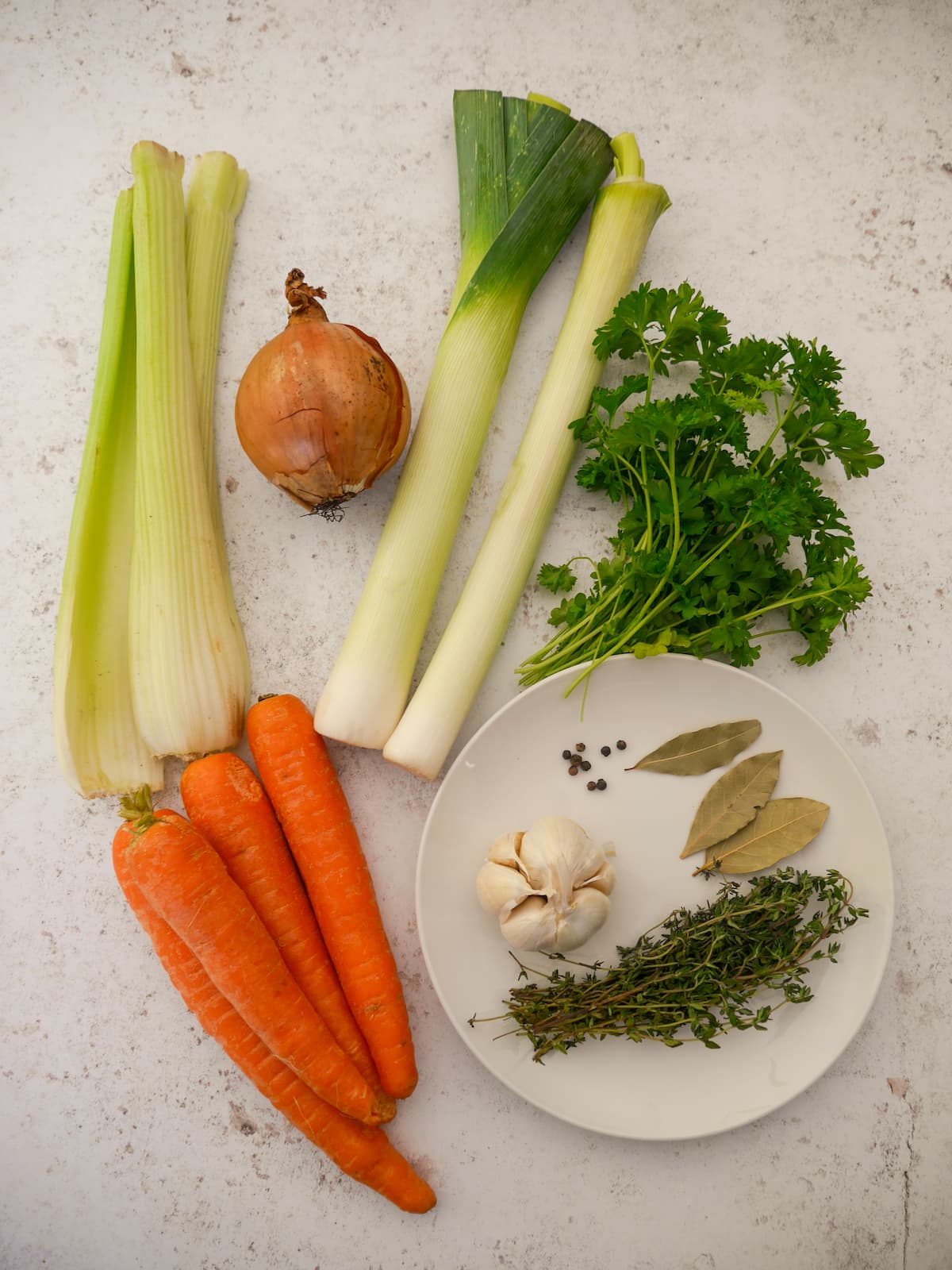
- Vegetables: I use a combination of onion, leek, carrot and celery in the stock.
- Fresh herbs: I flavour vegetable stock with a whole bulb of garlic, sprigs of fresh thyme, stalks of parsley and a bay leaf.
- Pepper: I add just 5 whole black peppercorns to season and flavour the stock.
How to make chicken stock in slow cooker
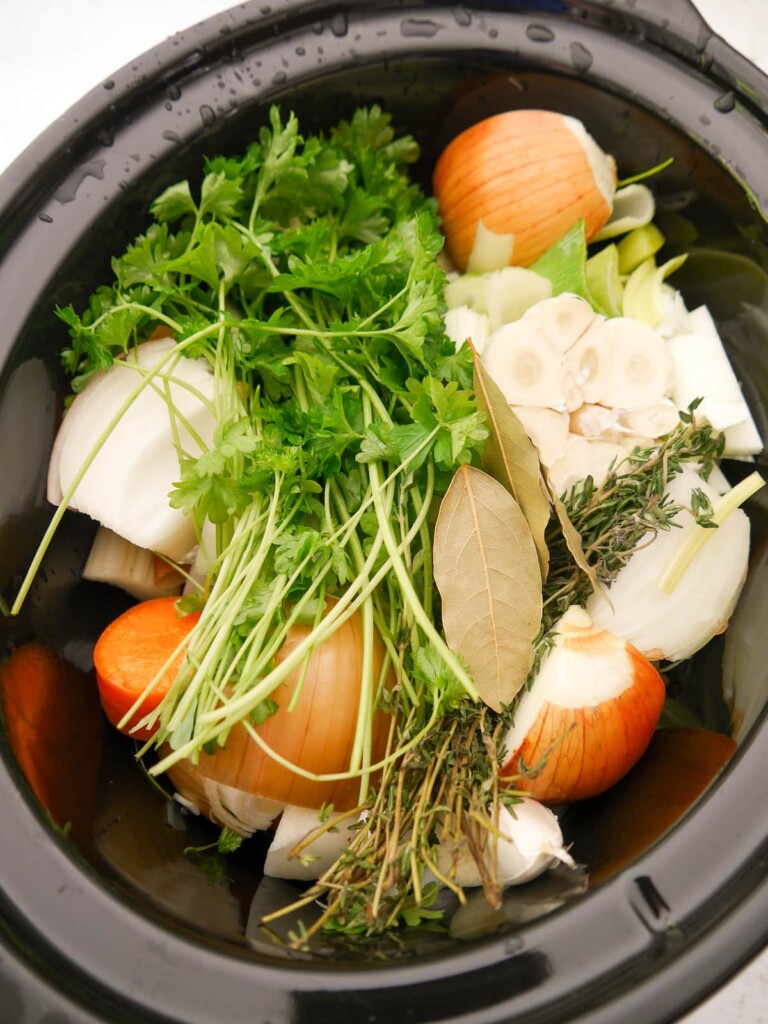
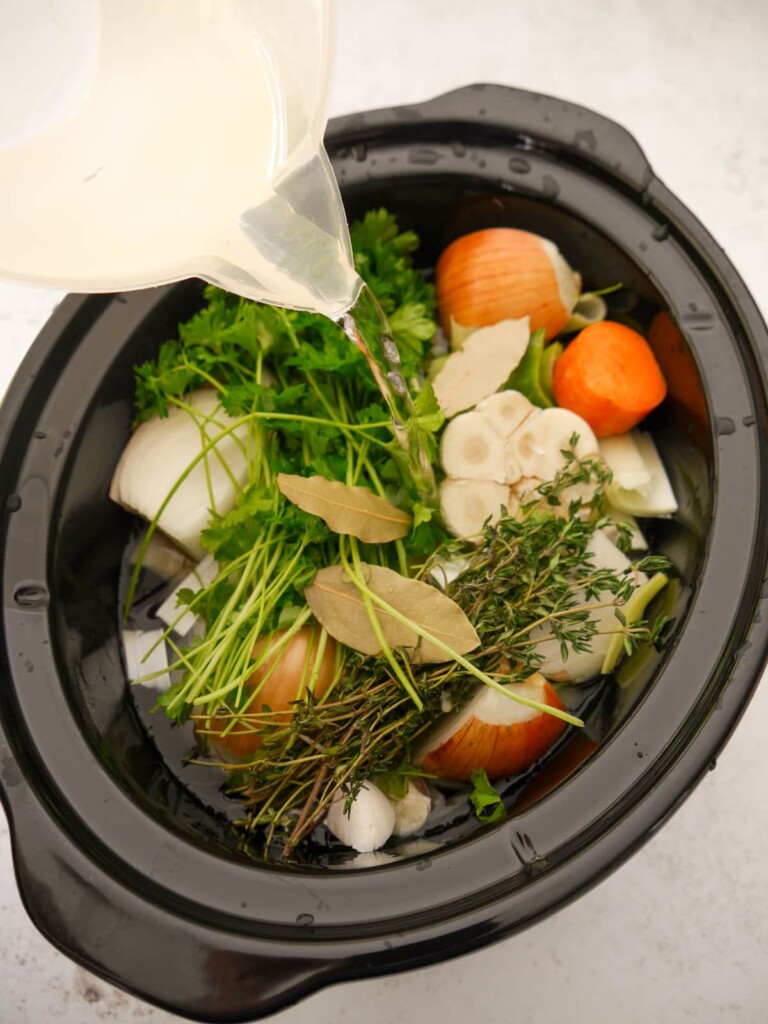
- Place all the ingredients into the bowl of your slow cooker and add approximately 2 litres of cold water (enough to cover all the vegetables).
- Put the lid on and turn the slow cooker to LOW. Cook for 6 hours.
LESLEY'S TIP: The stock is ready to use after 6 hours, but if time allows, turn the slow cooker off and leave the vegetables to sit in the stock overnight which will intensify the flavours.
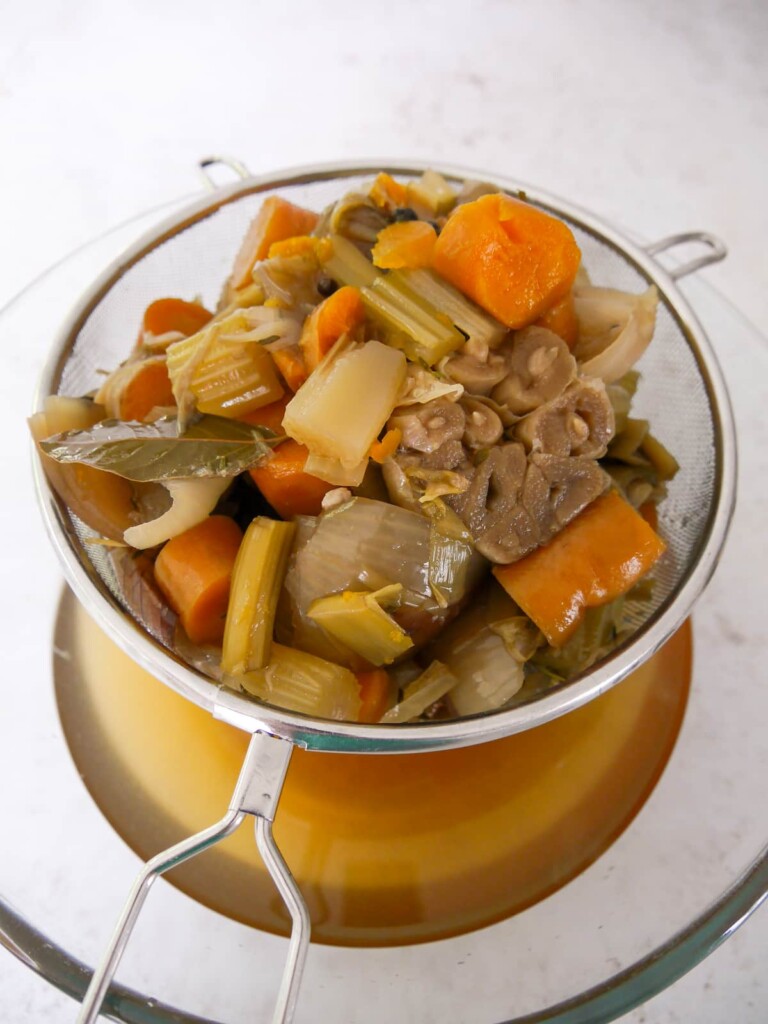
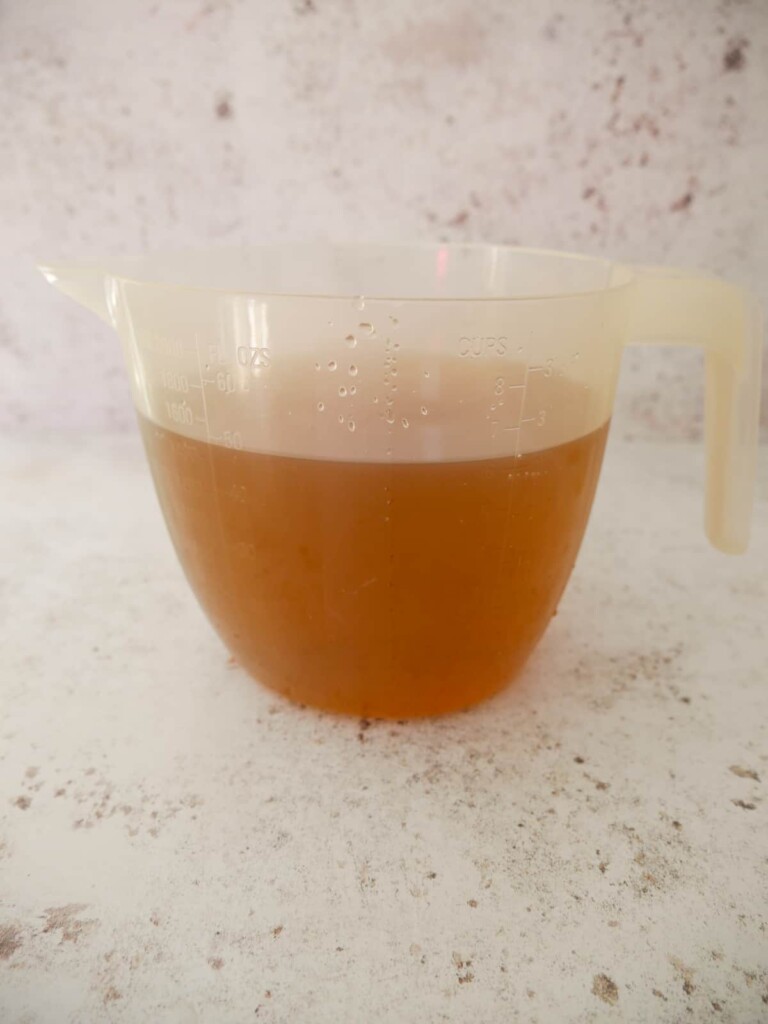
- Place a sieve over a large bowl or jug and pour the stock and vegetables into the sieve.
- Leave to drain for an hour so you get as much stock as possible drained off.
- Discard the vegetables and pour the stock into containers until you are ready to use.
- This recipe will give roughly 1 litre of vegetable stock.
How to make vegetable stock on stove top
I've opted to make vegetable stock using my slow cooker as it means I don't need to stand over it. However, you can make it on the stove top.
- Place all the ingredients into a large saucepan or Dutch oven.
- Put on the lid and bring to a boil.
- Turn the heat down to low and simmer gently for 2-3 hours.
- Then finish and strain the stock as detailed above.
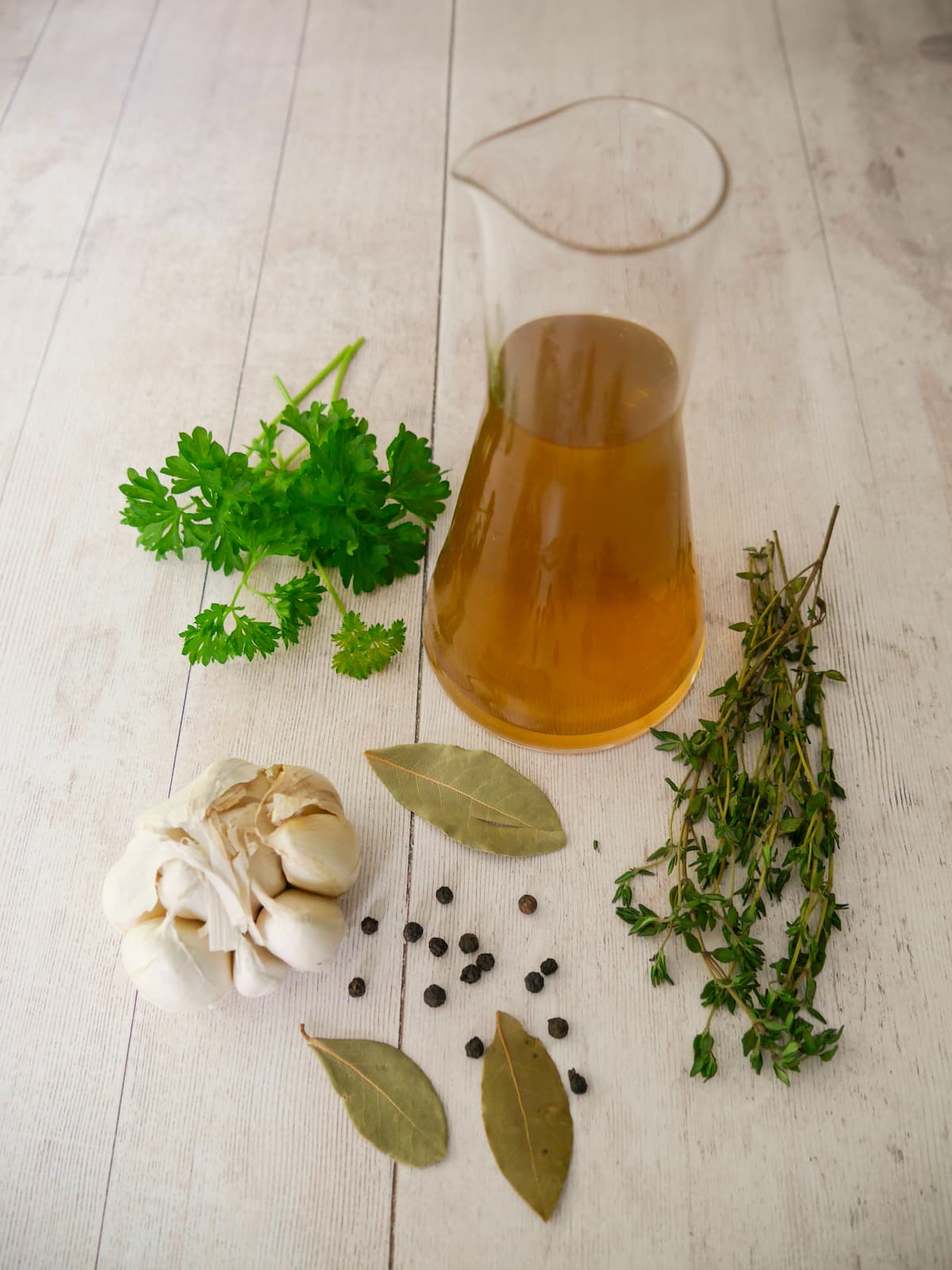
Recipe variations
- Vegetables - you can add in other vegetables like tomatoes, mushrooms (fresh or dried), red bell peppers, and fennel to the stock.
- Fresh herbs - I used a combination of thyme, parsley and bay leaves, but you can add in other fresh herbs like basil, oregano or rosemary, it depends on what you plan to use the stock for.
- Garlic - I add garlic to vegetable stock as I tend to use it in soups and dishes where I want the flavour of garlic to come through. If you don't want a strong garlic flavour you can cut down the amount or leave it out entirely.
- Aromatics - this recipe is easily adapted to include other aromatics. For example, add some fresh ginger and chilli, along with some star anise and Szechuan peppercorns, and you have a great vegetable stock for using in Chinese inspired dishes.
What vegetables should not be used in stock?
- Cruciferous vegetables - from the brassica family, like broccoli, cabbage, cauliflower or sprouts are far too bitter and have an overpowering flavour that will ruin the stock.
- Starchy vegetables - avoid starchy vegetables like potatoes and sweet potatoes as they don't have a strong flavour and make the stock cloudy and gummy. Beetroot is another starchy vegetable that will ruin stock both in flavour and colour.
- Others - green bell peppers and aubergine (eggplant) are bitter, courgette (zucchini) and squash add little flavour but can impact the texture of the stock.
How to use vegetable stock
Having good quality vegetable stock in your freezer is great for adding to a variety of different dishes and I always use is as a base for my Easy Vegan Gravy.
It's great in vegetable based soups like this Scottish Yellow Split Pea Soup, Potato & Leek Soup with Chickpeas, Leek & Barley Broth or my Curried Chickpea & Vegetable Soup. Or in main dishes like this Spring Vegetable Risotto or my Bean Chilli.
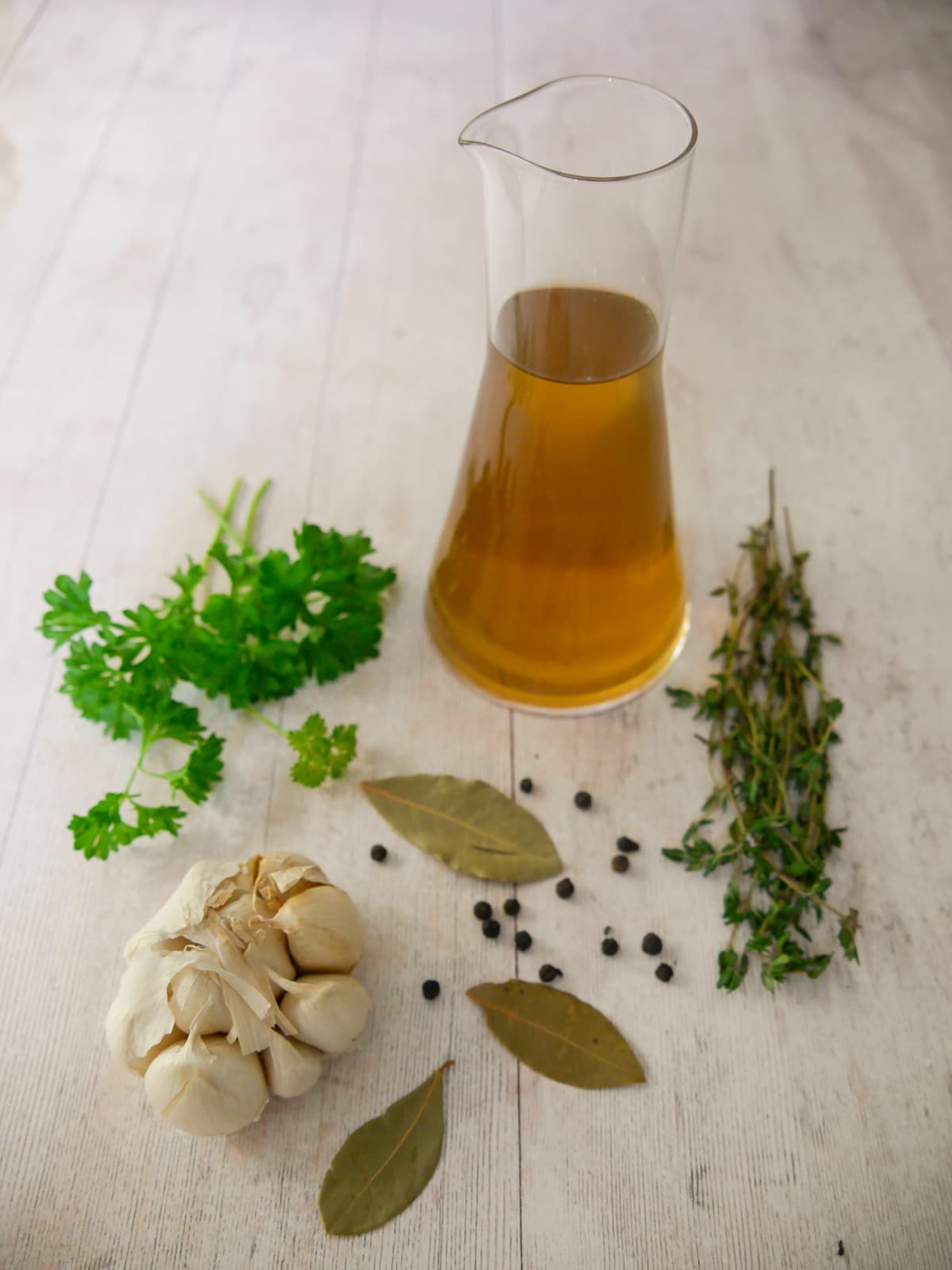
Useful hints and tips
- Where possible, I just give the vegetables a wash to remove any dirt, and I also remove any dead or wilted parts. The flavour in vegetables is often close to the skin, so where possible I leave it.
- Remove any tough outer layers of onion, but leave the softer brown skin attached as there is flavour in that too. This will give you a browner stock, so if you want a very clear vegetable stock you can remove the onion skin.
- Where possible, allow the vegetables and stock to sit overnight, this allows the flavours to intensify, resulting in a better flavoured stock.
- Leave the stock to sit and drain as you want to get as much stock as you can out of the vegetables and herbs.
- Do not add salt to stock! I never add salt to any homemade stock I’m making, as I’m not always sure what I’ll be using it for. If you’re going to be reducing it down, eg in a sauce, it will only become more salty as the stock reduces. Instead I prefer to add stock to to the dish I’m preparing and then add the salt depending on what that dish is.
- Once cooked discard the vegetables as they have been cooking for 6 hours so there is very little flavour left in them.
- For a more intense flavour you can boiling the stock down to reduce the amount of water diluting the stock.
- Allergy advice: gluten free, dairy free, egg free, soya free and nut free. For comprehensive and detailed allergy advice go to Allergy UK.
FAQs
Store the stock in any size of container. I usually store stock in 450ml/1/2 pint bags. You can store in the fridge for up to 5 days.
Yes, it's really easy to freeze vegetable stock. Portion the cooled stock into containers or Ziploc bags. You could also store stock in ice cube trays if you use really small amounts. Then place in the freezer and use within 6 months.
Pin the recipe
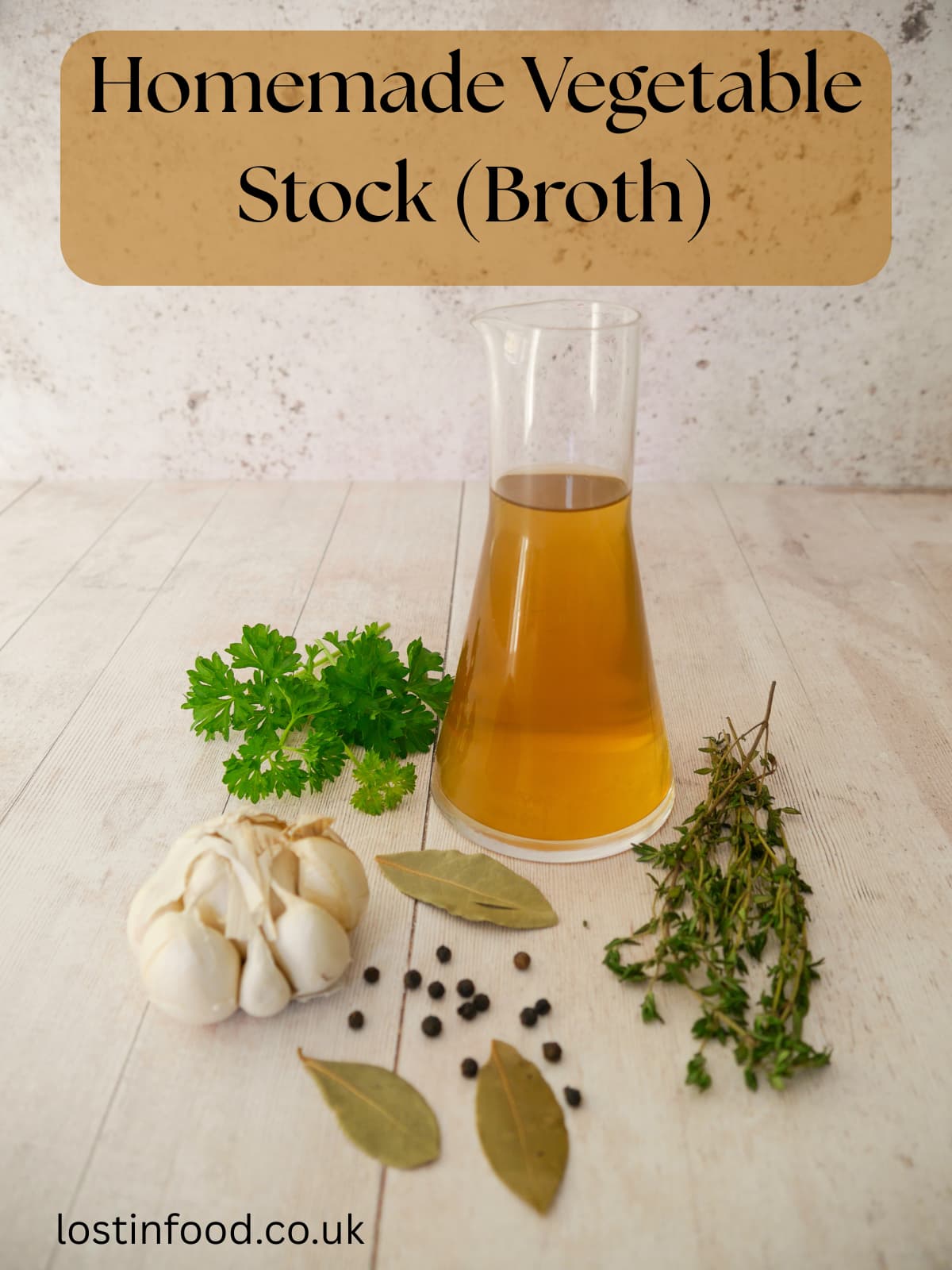
Additional recipe suggestions
If you like this recipe then try some of my favourite homemade stocks and sauce recipes:
- Homemade Chicken Stock (Slow Cooker)
- Fresh Tomato Stock
- Homemade Mayonnaise
- Classic French Dressing
- Honey Mustard Dressing
- Wild Garlic Salsa Verde (Green Sauce)
- Creamy Horseradish Sauce
- Yogurt, Lemon & Tahini Sauce
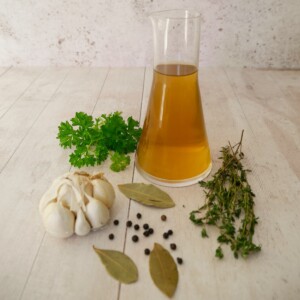
Homemade Vegetable Stock (Slow Cooker)
Equipment
- chopping board
- Sharp kitchen knife
- Measuring jug
- Slow cooker
- Storage containers or Ziploc freezer bags
Ingredients
- 1 ½ onion (roughly chopped)
- 2 leeks (roughly chopped)
- 4 carrot (roughly chopped)
- 3 stalks celery (roughly chopped)
- 1 bulb garlic (halved)
- 2 sprigs thyme
- 1 handful parsley leaves and stalks
- 2 bay leaf
- 10 black peppercorns
- 2 ltrs water
Instructions
- Place all the ingredients into the bowl of your slow cooker and add approximately 2 litres of cold water (enough to cover all the vegetables).
- Put the lid on and turn the slow cooker to LOW. Cook for 6 hours.
- The stock is ready to use, but if time allows, turn the slow cooker off and leave the stock to sit overnight which will intensify the flavours.
- Place a sieve over a large bowl or jug and pour the stock and vegetables into the sieve.
- Leave to drain for an hour so you get as much stock as possible drained off.
- Discard the vegetables and pour the stock into containers until you are ready to use.
- This recipe will give roughly 1 litre of vegetable stock.
Notes
- Where possible, I just give the vegetables a wash to remove any dirt, and I also remove any dead or wilted parts. The flavour in vegetables is often close to the skin.
- I remove any tough outer layers of onion, but leave the softer brown skin attached as there is flavour in that too. This will give you a browner stock, so if you want a very clear vegetable stock you can remove the onion skin.
- I add garlic to vegetable stock as I tend to use it in soups and dishes where I want the flavour of garlic to come through. If you don't want a strong garlic flavour you can cut down the amount or leave it out entirely.
- Don't use cruciferous vegetables from the brassica family in stock, like broccoli, cabbage, cauliflower or sprouts as they have far too bitter a flavour, that will ruin the stock.
- I also avoid starchy vegetables like potatoes, they don't have a strong flavour and make the stock cloudy and gummy.
- I don't add any salt to vegetable stock, as there are times when I will want to reduce the stock to make a sauce or jus. If the stock contains salt, the saltiness will only intensify when reduced, becoming too salty.
- Once cooked discard the vegetables as they have been cooking for 6 hours so there is very little flavour left in them.
- For a more intense flavour you can boiling the stock down to reduce the amount of water diluting the stock.
- Store the stock in any size of container. I usually store stock in 450ml/1/2 pint bags. However, you could also store stock in ice cube trays if you use really small amounts.
• Please note that the nutrition information provided above is approximate and meant as a guideline only •

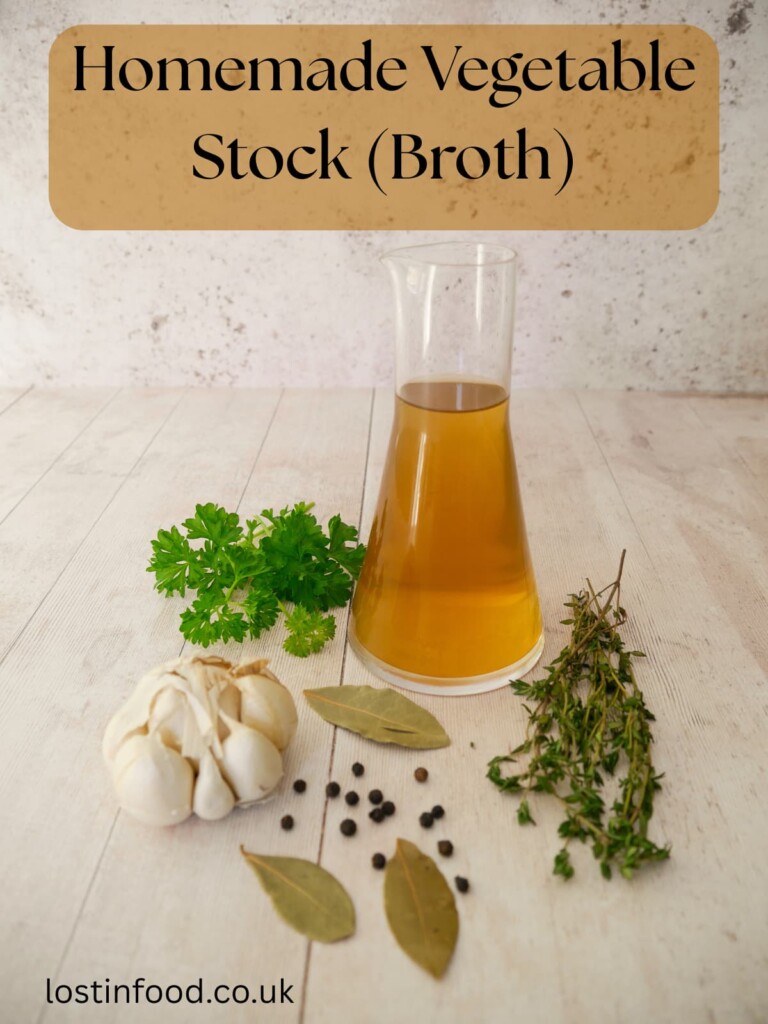
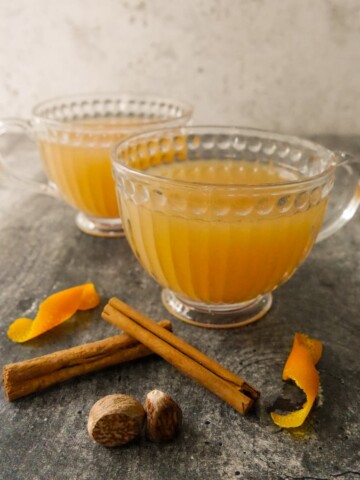
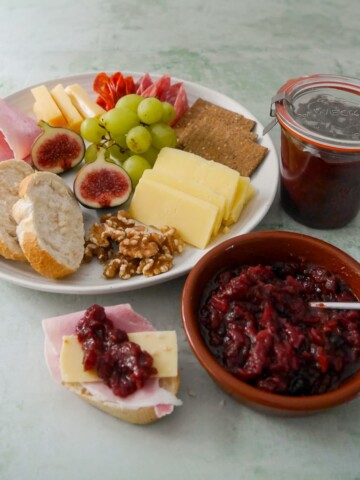
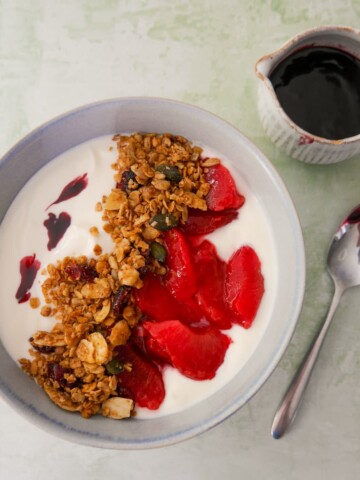
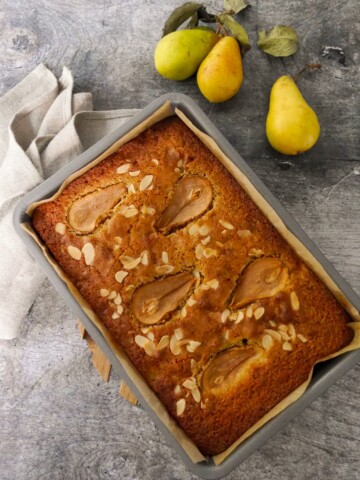
Chloe Edges says
This is so handy to have as an option to make a tasty stock when there are no meat bones around - and the depth of flavour was surprising considering its just veg - really good!
Lesley says
Thanks Chloe, it's a great way to use up leftover bits and pieces of veg.
Janice says
This was so easy to make and tasted delicious. I used the stock to make some vegetable soup and everyone loved it.
Lesley says
Thank you Janice, I agree it's so easy to make your own stock and it really does make a great bowl of soup.